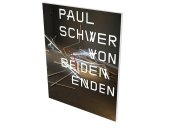 Neuerscheinungen 2018Stand: 2020-02-01 |
Schnellsuche
ISBN/Stichwort/Autor
|
Herderstraße 10
10625 Berlin
Tel.: 030 315 714 16
Fax 030 315 714 14
info@buchspektrum.de |

Jan Hoet, Gregor Janssen, Stephan Mann, Paul Schwer, Ludwig Seyfarth
(Beteiligte)
Paul Schwer: Von beiden Enden
Katalog zur Ausstellung im Museum Ratingen, Museum Goch
Herausgegeben von Mann, Stephan; Mitarbeit: Schwer, Paul; Vorlage: Schwer, Paul
2018. 128 S. 80 Farbfotos. 300 mm
Verlag/Jahr: SNOECK 2018
ISBN: 3-86442-262-0 (3864422620)
Neue ISBN: 978-3-86442-262-1 (9783864422621)
Preis und Lieferzeit: Bitte klicken
Keine Schönheit ohne Gefahr
Paul Schwer ( 1951) interveniert mit Aplomb durch seine plastischen und malerischen Werke in bestehende Architekturen oder landschaftliche Gegebenheiten. Dabei zielt sein Formen- und Materialienrepertoire von jeher auf die autonome Skulptur, weil sich in ihr die kulturellen und sozialen Verhältnisse am prägnantesten widerspiegeln. -Angefangen hatte alles Ende der 1980er Jahre in der Malerei mit -gegenständlichen -Motiven, deren Stofflichkeit sich durch verwischt wirkende Farbkonstellationen aufzulösen schien. Dann drängte es den Künstler in den 1990er Jahren in den Raum, seine Bilder verließen die Wand, und in dem von ihm entwickelten, spiralförmig wie eine DNA sich windenden Muster verzahnten sich Farbe und Licht mit Raum und Bewegung. So -entstanden Arbeiten, die sowohl roh, spröde, wie gebastelt wirken, aber auch auratisch leuchten und schlicht schön sind. Stephan Berg (Kunstmuseum Bonn) erkannte darin eine Mischung aus poetischer Beschwingtheit und Weichheit, die sich zwischen den Polen (konstruierter) Statik und (kontingenter) Dynamik hin- und herbewegt. Oder wie Johann Hartle (Amsterdam) meinte, indem er einen Songtitel der Einstürzenden Neubauten zitiert: "Keine Schönheit ohne Gefahr." Für Hartle führt die Arbeit von Paul Schwer diese zwei Begriffe in einer Raumsymbolik zusammen, die die Spontanität der politischen Äußerung wie auch der Aneignung des eigenen Körpers befördert. Hartle führt dazu einen Bonmot Sartres an: Der Künstler ist wie ein Hund ohne Kleinhirn, dem jede Sicherheit, jede Bindung und jede Gewissheit verloren gegangen ist. Mit seiner heroischen, sich selbst auslöschenden Idee künstlerischer Autorschaft im Moment gefährlicher Schönheit bestätigt Paul Schwer diese Charakterisierung des Künstlers mit abenteuerlichem Herz!
Ausstellungen:
Museum Ratingen, 29/6–30/9/2018
Museum Goch, 1/7– 9/9/2018
No Beauty without Danger
With quiet composure, the sculptures and paint-ings by Paul Schwer ( 1951) intervene in existing architectures and features of the landscape. His repertoire of forms and materials has always -fo-cused on autonomous sculpture, since it appears to most poignantly reflect cultural and social con-ditions. It all began in the late 1980s in paintings with figurative motifs; their materiality seemed to dissolve in blurry color constellations. Then, during the 1990s, he started to work three-dimensionally, his paintings left the wall, and in a pattern he de-veloped, spiraling like a DNA, color and light interlinked with space and movement. The result are works that are both rough, brittle and seemingly crafty, but also seem to have a special aura; they are simply beautiful. Stephan Berg (Kunstmuseum Bonn) recognized in them a mixture of poetic -exuberance and softness that moves back and forth between the poles of (constructed) statics and (contingent) dynamics. Johann Hartle (Amsterdam) quoted a song title by Einstürzende Neu-bauten: Keine Schönheit ohne Gefahr (No beauty without danger). For Hartle, Paul Schwer´s work combines these two concepts in a spatial symbol-ism that promotes the spontaneity of political -expression with the appropriation of one´s own body. Hartle refers to a bon mot by Sartre: The -artist is like a dog without a cerebellum that has lost all sense of security, attachment and certainty. With his heroic, self-effacing idea of artistic authorship in the moment of dangerous beauty, Paul Schwer confirms this characterization of the artist with adventurous heart!
Exhibitions:
Museum Ratingen, 29/6–30/9/2018
Museum Goch, 1/7– 9/9/2018


